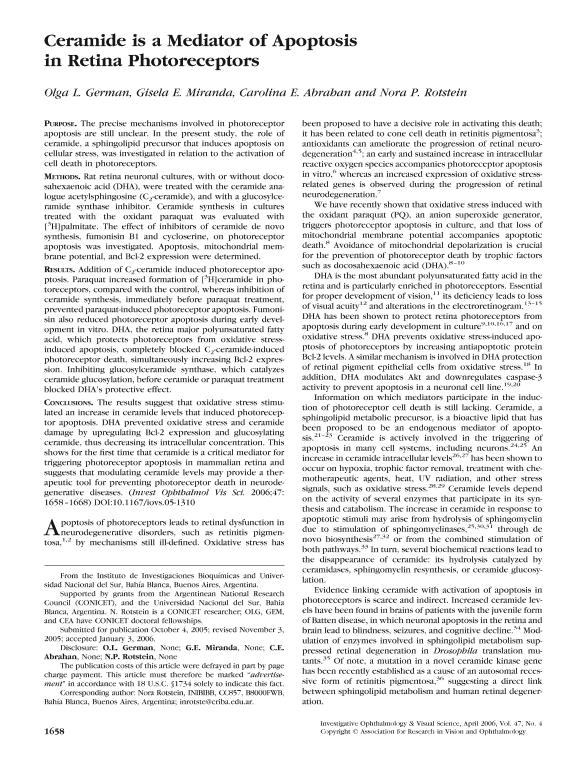Artículo
Ceramide is a Mediator of Apoptosis in Retina Photoreceptors
Fecha de publicación:
04/2006
Editorial:
Association for Research in Vision and Ophthalmology
Revista:
Investigative Ophthalmology & Visual Science
ISSN:
0146-0404
e-ISSN:
1552-5783
Idioma:
Inglés
Tipo de recurso:
Artículo publicado
Clasificación temática:
Resumen
PURPOSE. The precise mechanisms involved in photoreceptor apoptosis are still unclear. We here investigated the role of ceramide, a sphingolipid precursor that induces apoptosis upon cellular stress, in activating this death in photoreceptors. METHODS. Rat retina neuronal cultures, with or without docosahexaenoic acid (DHA), were treated with the ceramide analog acetylsphingosine (C2-ceramide), and with a glucosylceramide synthase inhibitor. Ceramide synthesis in cultures treated with the oxidant paraquat was evaluated with [3H]palmitate. The effect of inhibitors of ceramide de novo synthesis, fumonisin B1 and cycloserine, on photoreceptor apoptosis was investigated. Apoptosis, mitochondrial membrane potential and Bcl-2 expression were determined. RESULTS. Addition of C2-ceramide induced photoreceptor apoptosis. Paraquat increased formation of [3H]ceramide in photoreceptors, compared to controls, while inhibition of ceramide synthesis, immediately before paraquat treatment, prevented paraquat-induced photoreceptor apoptosis. Fumonisin also reduced photoreceptor apoptosis during early development in vitro. DHA, the retina major polyunsaturated fatty acid, which protects photoreceptors from oxidative stress-induced apoptosis, completely blocked C2-ceramide-induced photoreceptor death, simultaneously increasing Bcl-2 expression. Inhibiting glucosylceramide synthase, which catalyzes ceramide glucosylation, before ceramide or paraquat treatment blocked DHA protective effect. CONCLUSIONS. Our results suggest that oxidative stress stimulated an increase in ceramide levels, which induced photoreceptor apoptosis. DHA prevented oxidative stress and ceramide damage by up regulating Bcl-2 expression and glucosylating ceramide, thus decreasing its intracellular concentration. This shows for the first time that ceramide is a critical mediator for triggering photoreceptor apoptosis in mammalian retina and suggests that modulating ceramide levels might provide a therapeutic tool for preventing photoreceptor death in neurodegenerative diseases.
Palabras clave:
Ceramide
,
Photoreceptor
,
Docosahexaenoic Acid
,
Oxidative Stress
Archivos asociados
Licencia
Identificadores
Colecciones
Articulos(INIBIBB)
Articulos de INST.DE INVEST.BIOQUIMICAS BAHIA BLANCA (I)
Articulos de INST.DE INVEST.BIOQUIMICAS BAHIA BLANCA (I)
Citación
German, Olga Lorena; Miranda, Gisela Edit; Abrahan, Carolina Elizabeth; Rotstein, Nora Patricia; Ceramide is a Mediator of Apoptosis in Retina Photoreceptors; Association for Research in Vision and Ophthalmology; Investigative Ophthalmology & Visual Science; 47; 4; 4-2006; 1658-1668
Compartir
Altmétricas




